G S
S
According to contemporary Baseball thinking, the “good hitter” is a batter who waits patiently for a pitcher to make a mistake (put the ball where he doesn’t want to—where he knows the batter is most capable of hitting it), and capitalizes on it, and effectively hits the ball with authority at least 2.72 times out of 10 at-bats. To me, there are many ways to be a “good” hitter, but only one way to be a “Great” hitter. The good hitter will wait and hopefully hit the pitcher’s mistake. The great hitter will be able to hit the pitcher’s best pitch.
Since the current standard for being a good hitter is so low, then it might be well to presume that the standard for “perfection” is not or cannot be what a dictionary definition of perfection might imply. In Baseball, there is not an example of Ultimate Perfection. But under guidelines for what is defined as Penultimate, we can estimate the ultimate potential of those who might be the closest to perfection.
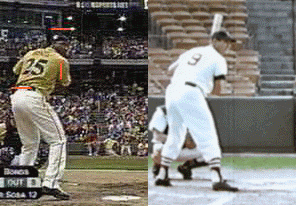
Astute analytical research on the topic of “The most productive means for becoming a most proficient Bats-man,” would have to begin with a visionary outline of what might be considered the various degrees of observable competence and perhaps the underlying characteristics (if any) of the ultimate form of excellence. Then, perhaps an elaboration of those varying degrees (with examples and illustrations) could describe the characteristics of each, and establish a platform for any prospective high achiever to undertake advancement toward that Ultimate goal.
Such a research paper might proceed as follows: (From my essay, “Four Dimensions of Bats-man-ship”)
Mastery of Bats-man-ship
l. Four Degrees (Dimensions) of Competence:
Fourth Degree – Ultimate Dimension
Third Degree – Penultimate Dimension
Second Degree – Scientific Dimension
First Degree – “Phenomenality” Dimension
For our purposes, I will elaborate on the 3rd and 4th degrees (since I’ve spoken enough on the 2nd and 1st degrees.
ll. Definition and Examples of 4th and 3rd Dimensions of Bats-man-ship:
A. Ultimate Dimension – A Spiritual dimension is the fundamental basis from which to build any endearing structure that will ultimately glorify the source rather than the effect of meritorious and magnificent display. The bats-man of the ultimate degree would be capable of hitting the ball squarely every time he swung his bat. Perfect application of a perfect principle probably sounds impossible, improbable, or at least over-imaginable. But, “Seek first the kingdom of Good and Its righteousness, and all these things shall be added unto you.”(Matt. 6:33) No mortal has yet demonstrated the competency that would exemplify ultimate bats-man-ship because mortal thought is incapable of comprehending and extending the probable components necessary to manifest the ultimate bats-man.
B. Penultimate Dimension – Highest Human demonstration of the scientifically artistic display of bats-man-ship does not quite reach the level of perfection for which all batters (consciously and unconsciously) strive in vain. The last man to hit .400 was almost considered a god for what was considered a batting average as close as one can get to perfection, with an efficiency rating that barely exceeded 40%. By attaining a “hit” in only 4 of 10 at-bats, Ted Williams was unsuccessful more often than he was successful, but still considered (by most) the greatest hitter in Baseball history.
His attempts at combining scientific understanding to his prominent physical endowment and artistry were seminal to a new wave of expanding thought, but were in no way conclusive to those who were to behold the first rays of his enlightened approach to hitting a baseball. And because his scientific inquiry did not have the benefit of modern technological scrutiny (video, slow-motion replay), as well as not taking into account every single aspect of the “batting-pitching” condition, he and others gleaned little from his merely intuitive but speculative hypotheses.
Technical flaws (although understandable now) prevented his progressive steps to the “gate” and possible entry into the realm of the “Ultimate” dimension. “Among them that are born of woman, none was greater than (Ted Williams) John the Baptist: not withstanding he that is least in the “Vortex” of heaven is greater than he.” (Matt. 11:11)
lll. Description: Ultimate Dimension – In the realm of mortal consciousness this dimension is non-existent. It only exists in the hopes and dreams of those whose childlike rebuke of the cold conventionality of human imperfection would stand in defiance to the claims of those stagnant horizons of self-imposed “status quo.” As the image and likeness of something greater than a vainglorious adulation of individual self-aggrandizement, he that would be capable of climbing to the supreme heights of ultimate bats-man-ship is one who is least fraught with a sense of personal prowess. Anyone aspiring to such a self-sacrificing commitment to nothing less than a Divine Principle has the only hope of attaining the grandest height of proficiency, for himself and those who would follow his example.
To “believe assuredly” is to have absolute faith in a proven principle. On the human level it’s hard to find an “Absolute” for which to have an absolute-faith. The True consciousness, in all of us, can discern the correct path to take, the right doctrine to espouse, and the most plausibly scientific way to hit a baseball. Could anyone besides a “Jesus” bat 1.000?
lV. Description: Penultimate Dimension – That chrysalis state from which an earnest achiever would merge into the ultimate of highest batting proficiency is obviously the closest step to perfection. If batting perfection is impossible on the human level, then would it not behoove any semblance of mankind to strive for a suitable facsimile thereof, to a level as close as possible to that ideal, instead of stagnating at the miry depth of conformity to the sub-.400 range of hitting a baseball.
If all reading this paper were in agreement with a collective goal of developing the highest possible batting proficiency at this level, then where must we begin to explore this nebulous realm of Penultimate dimension?
Taking the advice of Aristotle and the inspired Scribe of Psalms, is it possible to extrapolate, from the collective archival achievements of Baseball’s most formidable hitters, a hint of productive principle from which to glean a promising standard for enhanced batting efficiency?
Thoughtful consideration of a good many aspects of the entire batting regimen must be understood and applied conscientiously, in order for maximum proficiency to be demonstrated. The question has been, and might always persist. What is the proper regimen for establishing a technique that will procure the consistent, maximum effect while hitting a baseball? Many have theorized about the prospect, but only a handful have established credibility through their practical applications. But, of these, the closest to extracting a complete and understandable facsimile of truth has been Mr. Ted Williams, who happened to be the last Major League player to bat .400 over the course of an entire season.
Although Mr. Williams was nearly perfect in his understanding and application of the principles governing the absolute definition of batting prominence, he was not altogether unflawed in his actual approach to its impeccable demonstration. The closest exponent of the perfect batting technique was Barry Bonds. He, in obvious ways, superseded the brilliance that Ted Williams embodied. (The only thing difficult to decipher was whether or not he was conscious of his pre-eminent status as a pure extrapolation of principle. Or was he subject to faltering, due to his misrepresentation of the “Power-Principle” with an unsuitable penchant for the illusory enhancement of chemically induced stimulation?)
If Albert Einstein were a sports enthusiast, he’d probably not agree specifically with the Ted Williams statement that “hitting a baseball is the single-most difficult thing to do in all of sports.” He’d probably say that, “hitting a baseball for a home-run is the single-most difficult thing to do in all of sports.” To hit a home run, a batter has to be almost perfect in his application of the “the laws of physics” with regard to the mechanics of swinging a baseball bat with precision and power. To be a consistent home-run hitter the batter must also have an understanding of all the elements that are included in the dynamics of hitting a home run. (“Principle is absolute. It admits of no error, but rests upon understanding.” – Mary B. Eddy)
The “Home-Run Principle” is a formula that will explain the mechanics of hitting a home-run, not with complicated mathematical equations, but rather in terms of the simplicity that Einstein discovered in his “Relativity” theories as well as his Photo-Electric Effect which gave birth to the rationale for “Quantum Physics.” Theoretically, it is possible to hit a home run every time a batter swings his bat at a baseball. However, as Einstein and others have found, through Quantum Mechanics, when trying to establish the essence of matter, “at the fundamental levels, causation is a matter of statistical probabilities, not certainties.” Therefore, with all the elements and combinations of variables with which a batter has to deal, from within and from without himself, the “uncertainty principle” gives compelling testimony that mastering the “Rubik’s cube” of hitting a home run every time is highly improbable. However, the knowledge itself, of such feasibility, enhances the statistical probability of success.
Barry Bonds was capable of hitting in excess of 100 home runs and batting .400 or more, because he was closer to flawless technique than anyone who had ever played the game. His strength was incontestable, his athletic ability was indisputable, his timing was impeccable, and his stance, approach to the ball, and fluid mechanics were incomparable. In the few areas in which Ted Williams was lacking, Mr. Bonds was prolific. His only slight deficiency seemed to be in the realm of the mental accountability, which manifests itself physically at certain, momentary slumps.
What is it that Barry Bonds did consistently right that most, if not all other batters, only do sporadically? The answer is 5 separate things. They are the following:
1. He established a strong low center of gravity within his stance.
2. He limited the movement of his head and eyes in his stride.
3. He waited patiently for the ball to get to him.
4. When the ball did get to his hitting zone, 4 things happened simultaneously:
a. The front foot planted quickly and firmly as front leg straightened.
b. Front shoulder shrugged upward, while back elbow drove downward.
c. Back bent knee drove forward and down, as hips turned rapidly.
d. The shoulders followed the hips in rapid succession with arms extending through the contact of the ball.
5. From contact, through the straightening of arms, through the follow through, the shoulders were continuously flowing, until they (shoulders) had changed position (back to front and vice-versa).
Consistency in Batting effectiveness (Home Run proficiency) has never been more highly demonstrated than by Barry Bonds, in the 2001season, when he set what seems an insurmountable record, for any one but Barry Bonds himself. And, in 2002, he won his first (of what should have been many) “Batting Crown.” His extra power has catapulted him to a higher level than had been previously thought possible. When he wasn’t quite so strong, his drives were careening off the walls instead of sailing over the fences. Can he, or anyone else, get any stronger? And /or, is there anyone else smart enough to figure out how to duplicate his technique? “Truth is revealed! It needs only to be practiced.” – M. B. E.
Conclusion:
Here are some fundamental questions to ponder when embarking on a true evaluation of proper hitting technique:
1. What is the relationship of the direction and flight-angle of the ball thrown by the pitcher with respect to the opposite direction of the angle of the swinging bat and the force it exerts?
Unless a pitcher bends over, and down below a critical horizontal plane, and tosses the ball on a deliberately upward trajectory, every thrown pitch (100% of the time) is travelling in a descending line (or arc). It has been proven that even a Nolan Ryan fastball moves in a downward trajectory. Gravity and the fact that the pitcher is standing at least 10 inches above the plane of the batter and Home Plate are the two primary reasons.
2. Is it logical to develop, and/or teach-learn, the body – mechanics that facilitate a swinging bat to move downward to strike at a downward-moving ball? This would seem, at the least, counter-productive for effective “Bats-man-ship.” “Back-spin,” will be more effectively produced by a bat whose solid and direct contact is at a point just below the center of the ball.
3. Does not every “Speed-Gun” register the fastest speed of a pitch at the point closest to pitcher’s release of the ball? Hitting a baseball most effectively is determined by fractions of inches. Lunging forward, to hit a ball 2 or 3 feet in front of home plate, places the batter closer to the ball’s faster speed.
4. Does not the better hitter benefit significantly by keeping his head stationary as the body rotates through the swing?
Lunging out at the ball in front of the plate has a tendency to distort the batter’s perception of the ball because the lunge creates excessive movement of the head, which houses the visual mechanism.
5. Does the strength of the swing come from the stride, forward lunge of the body, and extension of the arms? Or does it come from the rapid and controlled rotary transfer of weight that occurs after the front foot plants and the front knee begins straightening to help force the front hip backwards to allow the back hip to move quickly forward, with a turning bent back leg?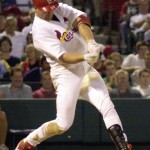
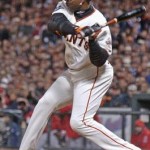
No one besides Mark McGwire (in 1998) positioned himself more majestically at the plate than Barry Bonds in 2001, 2002, 2003, and 2004seasons. Except for an extra 25-30 pounds of muscle weight, he looked as he always had, confident and supremely equipped to handle any type of ball the pitcher could throw.
As the pitch was delivered, his front foot strode forward, ever so slightly so as to maintain maximum visual acuity. His body gradually leaned over and down so he could maximized his perspective on a ball that he intuitively knew was traveling in a descending line or arc. With his front shoulder down and in, and his back elbow up, he waited until the last possible instant, while his hands rhythmically lowered his bat slightly below his waist and backward, then pushed down, hard, on his front foot, from which began the strong and rapid straightening of the front leg.
This action initiated the quick and powerful turning of the front hip, backwards, which automatically started the back hip forward with the assistance of the back bent-knee. At the same time that the lower body was administering its function, the right shoulder was instigating the preliminary movement to initiate the swinging of the bat.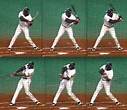
After the front foot-plant(at an angle of 120 degrees to the pitcher), the front shoulder, at its precise cue, “shrugs” upward, securing the shoulder girdle while maintaining a head and eyes that are completely still, focusing on the ball. The “shrug” creates the opportunity for the back shoulder to follow its natural downward thrust to initiate the action of the back elbow to drive forward. At this point, the hands have locked the wrists into place, from their previous swaggering momentum, and the entire body continues on its course, with the arms and bat trailing in a slightly upward direction to meet the ball at an angle of close to 180 degrees. The consistency of his bat meeting the ball at close to 180 degrees accounts for the fact that most of his Home Runs were carried on a trajectory of a high “line-drive.” The “Scientific-Art” of hitting a baseball certainly could be defined in the context of describing the ideal hitter– “He is one whose bat most consistently contacts the ball in a manner that facilitates a straight and ascending “line-drive.”(To hit the ball in any other manner would be to miss-hit it.)
No one in history had a more scientifically correct style for hitting a baseball than Barry Bonds. IF he had not unlawfully attempted to usurp the most glorious of crowns artificially, his higher understanding and application of the “Perfect Principle” would have attained it naturally.
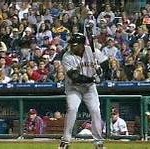

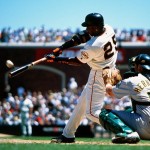

The scientifically minded “artist-of-the-bat” should understand and adhere strictly to the rules of his mental-physical application, and rest his performance on this sure foundation. He should hold his thought perpetually to the idea that his natural talent and indisputable scientific certainty can and will evoke from Principle the rule for mastering the most difficult task in all of sports.
Coming Soon: Throw Properly – Avoid “Tommy John”!
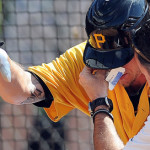 , and any of the others who have pulled hamstrings while running bases, when they could have been resting comfortably while mentally preparing to pitch the next inning? It doesn’t take an Einstein to figure out the logical, and rationally sound alternative to a pitcher batting. And two of the more recent incident s with Giants’ Ryan Vogelsong breaking his hand while swinging at a pitched ball, and most recently a “relief” pitcher (Santiago Casillas
, and any of the others who have pulled hamstrings while running bases, when they could have been resting comfortably while mentally preparing to pitch the next inning? It doesn’t take an Einstein to figure out the logical, and rationally sound alternative to a pitcher batting. And two of the more recent incident s with Giants’ Ryan Vogelsong breaking his hand while swinging at a pitched ball, and most recently a “relief” pitcher (Santiago Casillas 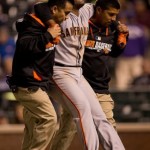 ) pulling a hamstring legging an infield out, thoroughly exacerbates an intelligent person’s perspective on what is meaningful in Baseball. Is it going to take a serious injury to Clayton Kershaw and Zack Greinke, or Stephen Strasberg, or their likes (Adam Wainwright for another)to finally come to the ultimate conclusion? I know that Kershaw, Strasberg, Greinke, Wainwright, and a few others think they have “batting prowess,” but their pitching is much more highly needed, without the risk of unnecessary injury.
) pulling a hamstring legging an infield out, thoroughly exacerbates an intelligent person’s perspective on what is meaningful in Baseball. Is it going to take a serious injury to Clayton Kershaw and Zack Greinke, or Stephen Strasberg, or their likes (Adam Wainwright for another)to finally come to the ultimate conclusion? I know that Kershaw, Strasberg, Greinke, Wainwright, and a few others think they have “batting prowess,” but their pitching is much more highly needed, without the risk of unnecessary injury.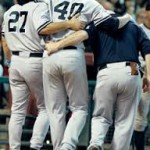 (C.- Ming Wang wishes he didn’t have to run the bases.)
(C.- Ming Wang wishes he didn’t have to run the bases.) 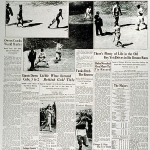 Just think of what it would have done for the fan-base as well as the extension of personal, individual worth to such Hall- of- Famers like Ruth, Jimmy Fox, Ted Williams, Yogi Berra, and many others, to be able to continue their careers even while subjected to a somewhat limited fielding capacity, but still highly productive offensively. The whole process only improves the quality of team performance, and adds continually to the appreciative adulation of fans. Everyone benefits by innovation, even the stagnant thinker, once he accepts the inevitable aspects of positive change.
Just think of what it would have done for the fan-base as well as the extension of personal, individual worth to such Hall- of- Famers like Ruth, Jimmy Fox, Ted Williams, Yogi Berra, and many others, to be able to continue their careers even while subjected to a somewhat limited fielding capacity, but still highly productive offensively. The whole process only improves the quality of team performance, and adds continually to the appreciative adulation of fans. Everyone benefits by innovation, even the stagnant thinker, once he accepts the inevitable aspects of positive change.
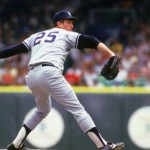
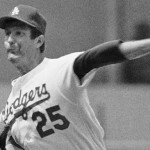
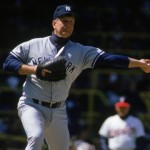

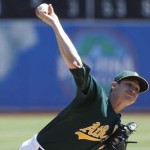
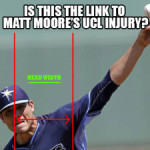
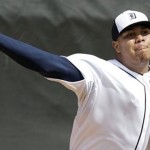

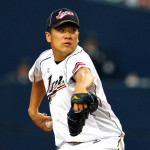
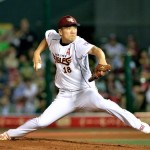
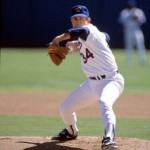
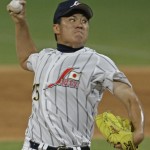
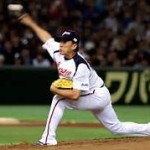 Obviously, the player with the stronger body and arm, who applies the mechanics perfectly, will be more effective than the weaker player. Also, not generally observed is the fact that, in throwing a baseball effectively, a principle law of physics always comes into play, namely, “. . . every action has an opposite and equal reaction.” If a player is right-handed, to be totally effective, he must use the left side of his body with the same intensity as he does the right, while performing the throw. This will enhance the power, as well as help secure balance with the proper follow-through. This application is analogous to that which a Karate Master invokes to maximize the power of a “strike” or “punch.” The force exerted backward(in “turnstile” fashion), by the front side of the body, not only accentuates the forward movement of the backside, but magnifies it, adding considerable power to the throw. (The same principle is expressed in swinging the bat.) The stronger the body the greater the possibility for a strong throw, as long as the application of the proper mechanics for movement of shoulder(s) and arm come into play. Unfortunately, the stronger the body, the greater is the opportunity for injury to the shoulder and arm if the application of proper mechanics is not enforced.
Obviously, the player with the stronger body and arm, who applies the mechanics perfectly, will be more effective than the weaker player. Also, not generally observed is the fact that, in throwing a baseball effectively, a principle law of physics always comes into play, namely, “. . . every action has an opposite and equal reaction.” If a player is right-handed, to be totally effective, he must use the left side of his body with the same intensity as he does the right, while performing the throw. This will enhance the power, as well as help secure balance with the proper follow-through. This application is analogous to that which a Karate Master invokes to maximize the power of a “strike” or “punch.” The force exerted backward(in “turnstile” fashion), by the front side of the body, not only accentuates the forward movement of the backside, but magnifies it, adding considerable power to the throw. (The same principle is expressed in swinging the bat.) The stronger the body the greater the possibility for a strong throw, as long as the application of the proper mechanics for movement of shoulder(s) and arm come into play. Unfortunately, the stronger the body, the greater is the opportunity for injury to the shoulder and arm if the application of proper mechanics is not enforced. 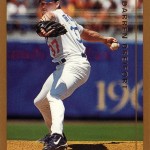
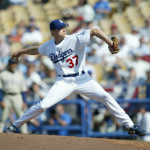
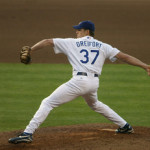
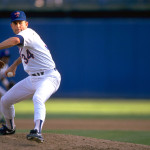
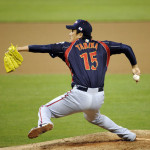
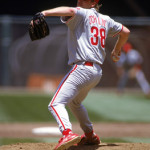

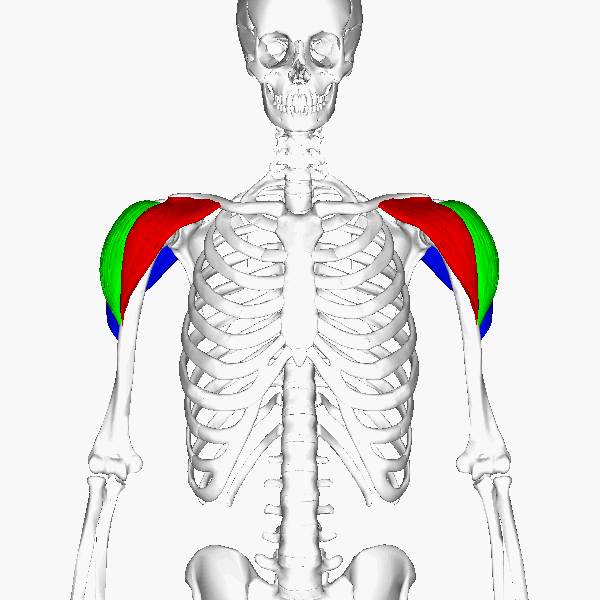
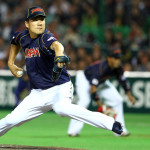 (Incidentally, the thrower’s position at this point looks similar to that of a person holding a bucket of water by the handle, and has just lifted it upward along the side of his body.) As the thrower moves sideways toward the “target,” a low center of gravity presents his body as in a low sitting position. As the front foot plants (toes pointed to-ward the target), the hips and torso begin to turn with the help of the bent front leg that is in the process of straightening.
(Incidentally, the thrower’s position at this point looks similar to that of a person holding a bucket of water by the handle, and has just lifted it upward along the side of his body.) As the thrower moves sideways toward the “target,” a low center of gravity presents his body as in a low sitting position. As the front foot plants (toes pointed to-ward the target), the hips and torso begin to turn with the help of the bent front leg that is in the process of straightening.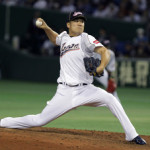
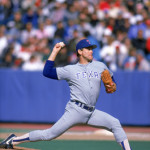 The backside (hip and torso) gains momentum from the back leg, with its pulling bent knee and pivoting foot. The throwing shoulder quickly rotates outwardly, to force its bent arm to bring the hand and ball upward, slightly above the shoulder. At this point, the muscles of the outwardly-rotated shoulder contract quickly (without hesitation), along with those of the entire upper body.
The backside (hip and torso) gains momentum from the back leg, with its pulling bent knee and pivoting foot. The throwing shoulder quickly rotates outwardly, to force its bent arm to bring the hand and ball upward, slightly above the shoulder. At this point, the muscles of the outwardly-rotated shoulder contract quickly (without hesitation), along with those of the entire upper body.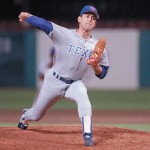 As the shoulder thrust is completing its full range of rolling-forward-motion(anterior deltoid), the arm quickly extends
As the shoulder thrust is completing its full range of rolling-forward-motion(anterior deltoid), the arm quickly extends 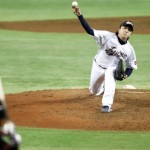
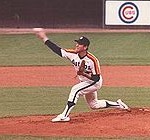
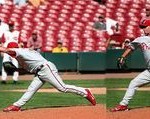 forwardly as forearm is in full pronation (not sideways
forwardly as forearm is in full pronation (not sideways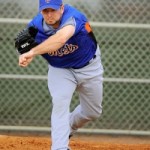
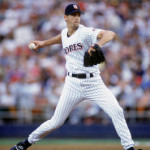
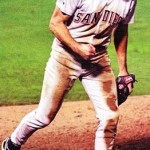
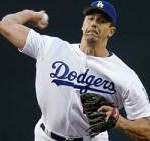

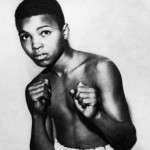
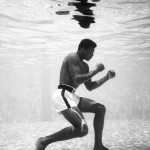

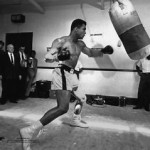
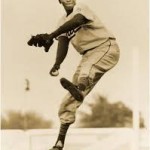
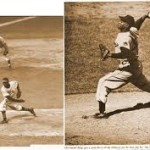

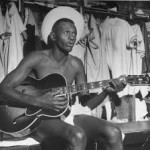

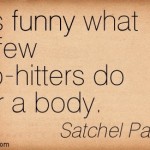
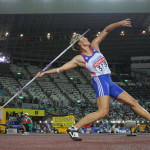 then critics are justified because there is no purposeful intent in such action, especially if it is repeated continuously. IF a pitcher (and even an Out-fielder) repeats such body and arm action countless times before a game (or even days before he is actually pitching) how does he expect to re-train his body and arm to function optimally when “it counts” under crucial game conditions.
then critics are justified because there is no purposeful intent in such action, especially if it is repeated continuously. IF a pitcher (and even an Out-fielder) repeats such body and arm action countless times before a game (or even days before he is actually pitching) how does he expect to re-train his body and arm to function optimally when “it counts” under crucial game conditions.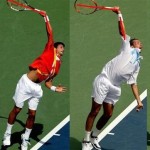
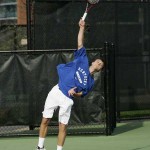
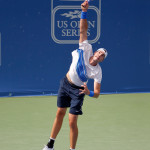













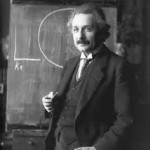

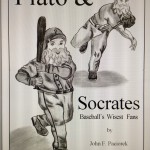
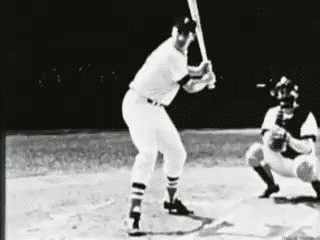
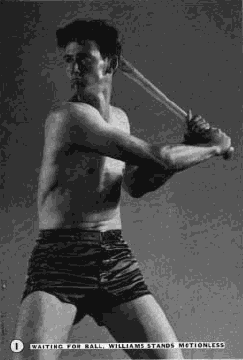
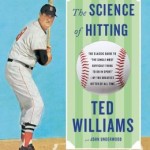
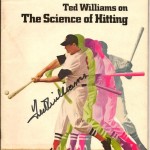
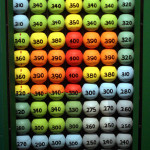
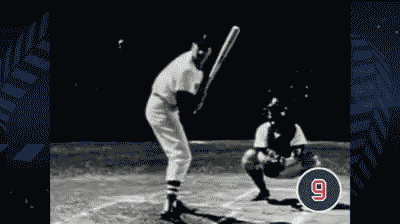 Bat united with ball for a brief moment to echo a glorified exuberance that resonated throughout the ballpark to sustain an illustrious piece of bats-man-ship. From the beginning of “gathering” body momentum, to the point where hickory and leather ignited a hint of scorching scent, the culmination of which transpired to a distinctively magnificent follow-through, the subjugated projectile took flight most often on a trajectory close to 180degrees (and climbing). (To hit the ball in any other manner would be to miss-hit it, and therefore denigrate any true artistic and scientific confluence).
Bat united with ball for a brief moment to echo a glorified exuberance that resonated throughout the ballpark to sustain an illustrious piece of bats-man-ship. From the beginning of “gathering” body momentum, to the point where hickory and leather ignited a hint of scorching scent, the culmination of which transpired to a distinctively magnificent follow-through, the subjugated projectile took flight most often on a trajectory close to 180degrees (and climbing). (To hit the ball in any other manner would be to miss-hit it, and therefore denigrate any true artistic and scientific confluence).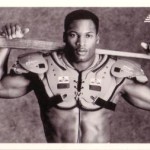
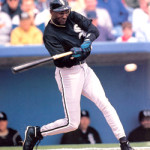
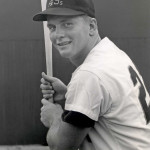
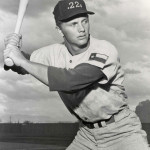 The other is that of a humble spirit, whose quiet confidence simply lets his actions speak for him, while appreciating and nurturing every opportunity to perform what he innately sees as his duty to do, and does it with exactness, and step by step progresses along constructive lines.
The other is that of a humble spirit, whose quiet confidence simply lets his actions speak for him, while appreciating and nurturing every opportunity to perform what he innately sees as his duty to do, and does it with exactness, and step by step progresses along constructive lines.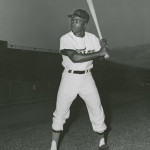
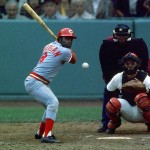
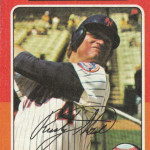
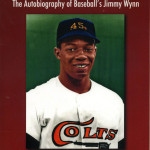

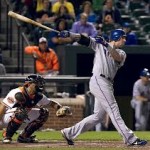
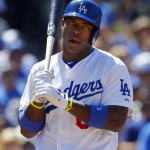
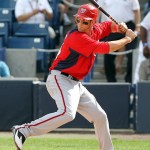
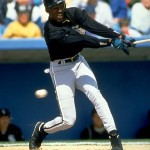
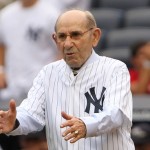
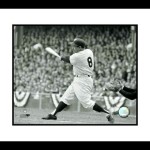


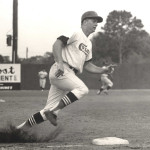
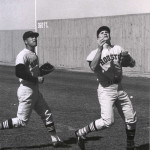 Any spare time, while not on the practice field, I’d be doing strength-building exercises with pulleys and “machinery” other than “weights” (my dad didn’t believe in “weights”- it could make me muscle-bound).
Any spare time, while not on the practice field, I’d be doing strength-building exercises with pulleys and “machinery” other than “weights” (my dad didn’t believe in “weights”- it could make me muscle-bound).